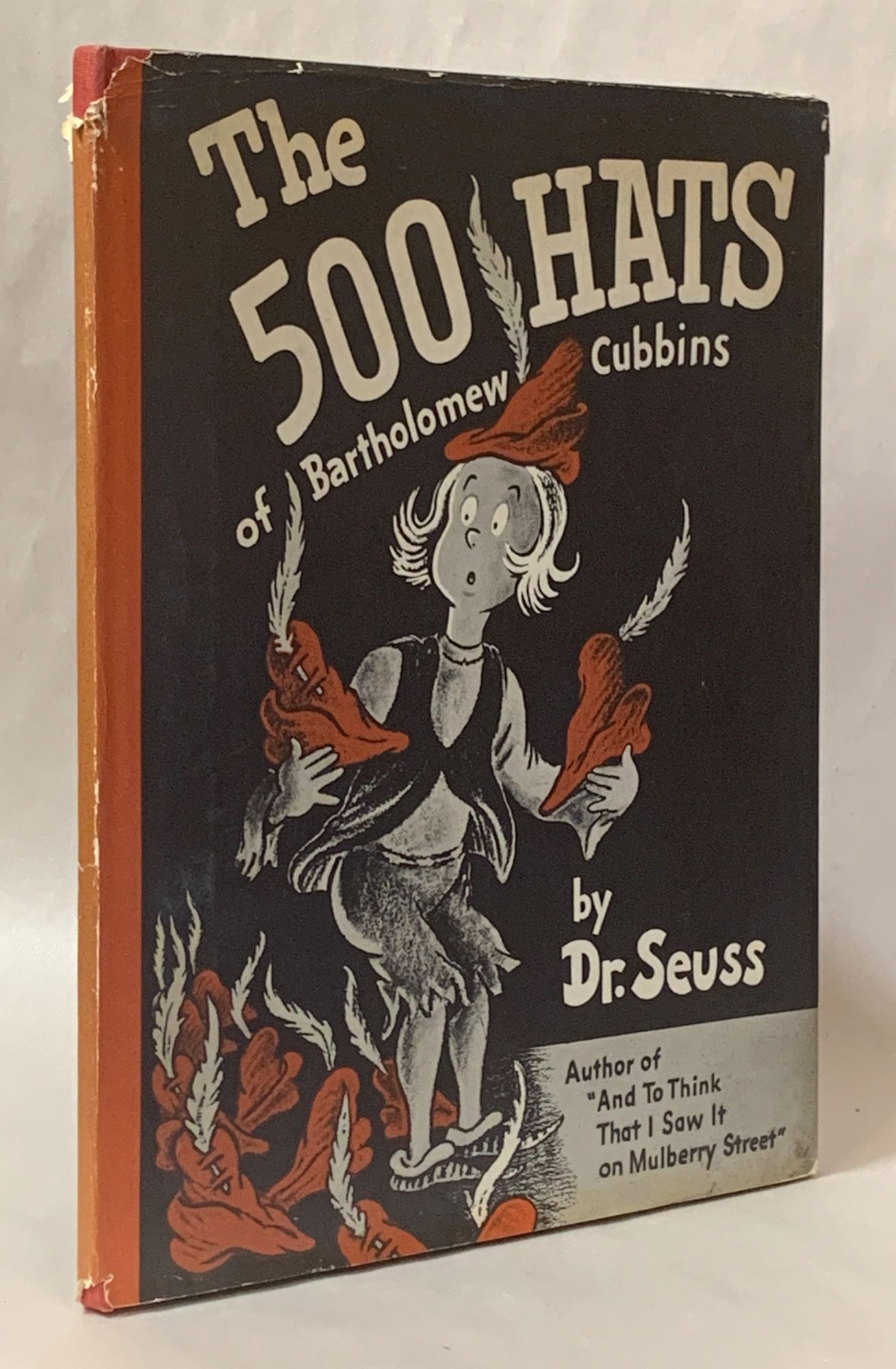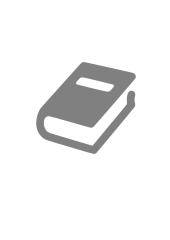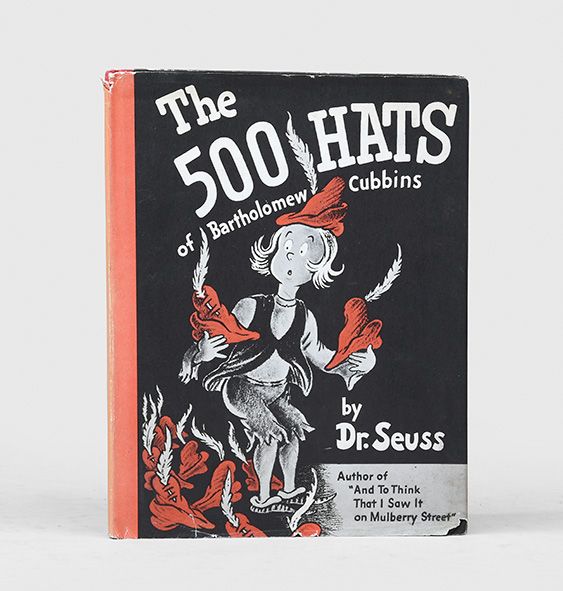Available Copies from Independent Booksellers

Seuss, Dr. The 500 Hats of Bartholomew Cubbins. The Vanguard Press, 1938.
Price: US$500.00 + shipping
Description: 9-1/4 by 12-1/4 inches. The second children's book by Theodor Seuss Geisel. Later printing, with $2.95 on the jacket flap. A very good copy with wear to the corners and edges. In a dust jacket with loss to the spine ends and scuffs to the rear panel. End papers illustrated with the titular hats. Pages clean. Original seller's small stamp on rear pastedown. The seller was John Cole's Books & Craft Shop in Seuss's adopted hometown of La Jolla, CA, where he lived after World War II until his death in 1991. Seuss was close friends with John and Barbara Cole and often signed books in their bookshop. With a copy of the original Cole's receipt with customer name matching the inscription laid in dated August 27, 1969. Inscribed on the front free endpaper: 'For the _____________ family with best wishes. Dr. Seuss.'.
Seller: Eureka Books, Eureka, CA, U.S.A.

Dr. Seuss. The 500 Hats of Bartholomew Cubbins (Signed by Dr. Seuss). Vanguard Press, 1938.
Price: US$2500.00 + shipping
Condition: Good
Description: [Early edition of Dr. Seuss' second book, inscribed by Seuss] The story of a young man, with a magic hat. Held in a custom-made, black leather clamshell case with an image of a red hat on the front, outlined in gold. Also comes in a red cloth bag (similar to Bartholomew's hat). Bound in rebacked red cloth over black pictorial boards. Some edge wear. Small chip missing from first end page. Cover shows red feathered hat pointing left. Back cover shows hat pointing right. Facsimile dust jacket. Autographed by author, "To Norma, (who is really to old for this sort of thing) - Dr. Seuss." Edition notes: Smaller hats on the pastedown endpapers. Younger & Hirsch 22.
Seller: Sequitur Books, Boonsboro, MD, U.S.A.

SEUSS, Dr.. The 500 Hats of Bartholomew Cubbins.. New York: Vanguard Press, 1938, 1938.
Price: US$4199.56 + shipping
Description: First edition of Seuss's second book, inscribed by the author to his literary agent, Jed Mattes, on the front free endpaper verso, "For Jed, one extra Hoot! Dr Seuss", with an original pencil drawing of a red hat. Mattes (1953-2003) took over from Seuss's previous long-term agent, Phyllis Jackson in 1977, and was known for his staunch advocacy on behalf of emerging gay writers. This is a later printing, published in the same year as the first, distinguished by the red hat illustrations on the endpapers, which flow right to left in the first printing, and left to right in this printing. Younger & Hirsch 22, later printing. Quarto. Original red cloth-backed black boards, spine lettered in black, front board lettered in white, and illustrated in red and white, illustrated endpapers. With dust jacket. Illustrated throughout by the author. Extremities rubbed and corners a little worn, a very good copy indeed, boards and contents bright and sharp, in the price-clipped dust jacket, spine faded, chips to head of spine and bottom right corner of front panel, extremities nicked, tape repair to rear panel, a very good example.
Seller: Peter Harrington. ABA/ ILAB., London, United Kingdom

Price: US$15000.00 + shipping
Description: First edition, early printing of Seuss's unique book of prose. Association copy, inscribed by the author on the pastedown, "For Maurice with many thanks for the Future! Dr. Seuss." The recipient, Maurice Sendak, is best known for his immensely popular illustrated childrenâs book, Where the Wild Things Are, which was awarded the Caldecott Medal in 1964 and gained him international fame. Sendak acquired the present volume, which had been previously signed by Seuss on the verso of the front free endpaper "For Alice, Best Wishes - Dr. Seuss", and brought it to the July 1, 1980 American Library Association Conference in New York where Seuss inscribed it personally to him, as is notated in Sendak's small ownership inscription above Seuss's. At that time, Sendak and Seuss would have been two of the most popular, and perhaps even controversial best-selling children's author in attendance. Sendak's career was launched in 1952 with the publication of Ruth Krauss's A Hole Is to Dig. Their author-illustrator collaboration, facilitated by Harper & Row publisher and editor-in-chief of juvenile books Ursula Nordstrom, became something of a cultural phenomenon, spawning a host of imitators of their âunrulyâ and ârebelliousâ child protagonists. Now one of the scarcest and most desirable books in modern childrenâs literature, Sendakâs Where the Wild Things Are faced many opponents and was banned in several libraries upon publication in 1963. Its challengers accused the work as being âtoo darkâ and âtraumatizingâ to young children due to its often frightening imagery." It would become one of many âgood books for bad childrenâ edited and published by Nordstrom who disliked the genteel, sentimental tone of earlier American childrenâs literature and sought to change its purpose to appeal to childrenâs imaginations and emotions, rather than serve as adult-approved morality tales. American childrenâs author and illustrator Theodore Seuss Geisel produced some of the most popular childrenâs books of all time under the pen name Dr. Seuss. Although most recognized for his vivid and original drawing style, Geiselâs works also carried a complexity that went beyond the function of entertaining children; many of his works had an autobiographical undertone and were written to be intentionally divergent from traditional childrenâs books. Rather than write stories to convey morals to children, many of Geiselâs stories expressed strong views on current social and political issues. Near fine in a very good dust jacket. An exceptional association. Unlike the majority of Geisel's books, The 500 Hats of Bartholomew Cubbins was written in prose rather than rhyming and metered verse. Geisel, who collected hats, got the idea for the story on a commuter train from New York to New England, while he was sitting behind a businessman wearing a hat; the passenger was so stiff and formal that Geisel idly wondered what would happen if he took the man's hat and threw it out the window. Geisel concluded that the man was so "stuffy" that he would just grow a new one. The book received positive reviews from critics. The New York Times reviewer called the book "a lovely bit of tomfoolery which keeps up the suspense and surprise until the end." Booklist, which had criticized Geisel's previous book, And to Think That I Saw It on Mulberry Street, for containing only enough material for one comic strip, praised The 500 Hats as "a brand-new idea, developed into a complete tale, not too long, not too short, just right. Somewhere between the Sunday supplements and the Brothers Grimm, Dr. Seuss has produced a picture book combining features of both."
Seller: Raptis Rare Books, Palm Beach, FL, U.S.A.